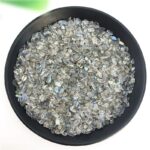Introduction:

Specularite hematite, a captivating metallic mineral, exhibits a distinct specular luster that sets it apart from its counterparts in the mineral kingdom. Its iridescent surface, resembling the sheen of polished metal, has sparked the imagination and ingenuity of artists, scientists, and industrialists alike for centuries. Its unique properties and versatile applications make it a highly sought-after material in various industries, unlocking a world of possibilities in fields ranging from construction to cosmetics.
Geological Origins and Natural Abundance:
Specularite hematite is a primary iron oxide mineral formed during the cooling and crystallization of iron-rich molten rock. Its primary geological origins include hydrothermal environments, iron-ore deposits, and volcanic eruptions. The mineral is widely distributed across the globe, with significant deposits found in Australia, Brazil, Canada, China, and the United States.
Physical and Chemical Properties:
Chemical Formula: Fe2O3
Crystal Structure: Trigonal
Hardness: 5.5-6.5 on the Mohs scale
Specific Gravity: 4.9-5.3 g/cm³
Cleavage: Excellent in basal planes
Fracture: Uneven
Color: Dark gray to black, metallic to submetallic luster
Streak: Red to reddish-brown
Industrial Applications:
1. Iron and Steel Production:
Specularite hematite is the primary iron ore used in the production of iron and steel. It is smelted in blast furnaces to extract the iron, which is then further processed and alloyed to create various grades of steel. The steel industry consumes a significant portion of global specularite hematite production.
2. Construction Materials:
Ground specularite hematite is used as a pigment in cement, concrete, and other construction materials. Its red-brown hue enhances durability and imparts a rich color to these materials. It is also used as a filler in asphalt and roofing tiles, adding strength and weather resistance.
3. Paints and Cosmetics:
Specularite hematite is used in the production of red iron oxide pigments, which are incorporated into paints, cosmetics, and other colorants. These pigments provide excellent coverage, durability, and colorfastness. The mineral’s natural luster adds a metallic shimmer to cosmetic products, creating eye-catching effects.
4. Glass and Ceramics:
Specularite hematite is used as a flux in glass and ceramic production. It lowers the melting point of the raw materials, enhancing flowability and reducing energy consumption during manufacturing. It also contributes to the formation of colored glazes and imparts a metallic sheen to decorative tiles.
5. Medical Applications:
Specularite hematite has been used in traditional medicine for centuries. It is believed to possess therapeutic properties, including blood purification, wound healing, and anti-inflammatory effects. It is also used in some modern medical devices as a contrast agent for magnetic resonance imaging (MRI).
Artistic and Decorative Uses:
1. Jewelry:
Specularite hematite is used in jewelry making due to its metallic luster and rich color. It is often cut and polished into cabochons or beads, creating striking necklaces, bracelets, and earrings. Its natural iridescence adds a unique touch of elegance to any piece.
2. Sculptures and Artwork:
Specularite hematite is used in sculptures and artwork as a decorative element. Its metallic texture and reflective surface create captivating visual effects, enhancing the overall aesthetic appeal of the piece.
3. Inlays and Mosaics:
Specularite hematite is used in inlays and mosaics to create intricate designs and patterns. Its sharp edges and contrasting color add depth and detail to these decorative works of art.
Innovative Applications:
1. Energy Storage:
Specularite hematite has been identified as a promising material for energy storage applications. Researchers are exploring its use in batteries and supercapacitors due to its high energy density and long cycle life.
2. Solar Cells:
Specularite hematite shows potential as a low-cost material for solar cell fabrication. Its semiconducting properties and high absorption of sunlight make it a promising candidate for efficient solar energy conversion.
3. Sensors:
Specularite hematite-based sensors are being developed for various applications. Its magnetic properties and high surface area enable it to detect gases, chemicals, and biological agents with high sensitivity and selectivity.
4. Coatings and Films:
Specularite hematite is used in the production of specialized coatings and films. Its metallic luster and durability make it a suitable candidate for reflective surfaces, decorative finishes, and protective layers.
Market Statistics and Future Outlook:
The global specularite hematite market is valued at approximately $6.5 billion and is projected to grow at a CAGR of 5.8% from 2023 to 2028. This growth is driven by increasing demand from the construction, steel, and paint industries.
Conclusion:
Specularite hematite, with its captivating metallic luster and versatile properties, continues to amaze and inspire. Its applications span a vast array of industries, from construction to cosmetics, and its potential for innovation is boundless. As research delves deeper into its unique characteristics, we can expect to uncover even more groundbreaking applications for this remarkable mineral in the years to come.




























